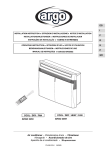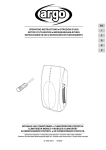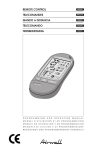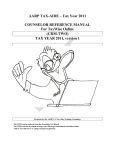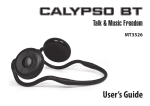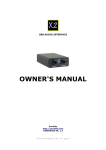Download Universal Remote Control Thermo Control Operating instructions
Transcript
EG OPERATING INSTRUCTIONS ● ISTRUZIONI D'USO NOTICE D’UTILISATION ● BEDIENUNGSANLEITUNG INSTRUCCIONES DE USO ● INSTRUCÇÕES DE FUNCIONAMENTO I F D E P MOVABLE AIR CONDITIONER ● CLIMATIZZATORE PORTATILE CLIMATISEUR MOBILE ● MOBILES KLIMAGERÄT ACONDICIONADOR PORTATIL ● AR CONDICIONADO PORTÁTIL Save these instructions / Conservate queste istruzioni / Conserver cette notice d’utilisation Bewahren Sie bitte diese Bedienungsanleitungen auf / Guardeis estas instrucciones / Guarde estas instruções 37.4252.008.2 06/2005 CONTENTS EG PRODUCT IDENTIFICATION...................................................................................... 2 SIGNALING LAMPS .................................................................................................. 3 BEFORE USING THE APPLIANCE............................................................................. 3 OPERATION ............................................................................................................... 4 USING THE REMOTE CONTROL UNIT..................................................................... 4 • How to install batteries .............................................................................................. 4 • Temperature sensor selector..................................................................................... 4 • Operation with the remote control unit....................................................................... 4 REMOTE CONTROL UNIT ......................................................................................... 5 HOW TO SET THE PRESENT TIME .......................................................................... 6 COOLING .................................................................................................................. 6 DEHUMIDIFYING (DRY)............................................................................................. 6 FAN ONLY................................................................................................................... 6 ADJUSTING THE FAN SPEED................................................................................... 6 SLEEP MODE.............................................................................................................. 6 SETTING THE TIMER................................................................................................. 7 SETTING THE AIR FLOW DIRECTION..................................................................... 8 HOW TO DISCHARGE THE WATER TANKS ............................................................. 8 OPERATION WITHOUT THE REMOTE CONTROL UNIT.......................................... 9 TIPS FOR ENERGY SAVING..................................................................................... 9 TROUBLESHOOTING............................................................................................... . 9 DECLARATION OF CONFORMITY This product is marked as it satisfies Directives: – Low voltage no. 73/23 EEC and 93/68 EEC. – Electromagnetic compatibility no. 89/336 EEC, 92/31 EEC and 93/68 EEC. This declaration will become void in case of of misusage and/or non observance though partial of manufacturer's installation and/or operating instructions. NOTE: This symbol mark and recycle system are applied only to EU countries and not applied to the countries in the other area of the world. Your product is designed and manufactured with high quality materials and components which can be recycled and reused. This symbol means that electrical and electronic equipment, at their end-oflife, should be disposed separately from your household waste. Please dispose of this equipment at your local community waste collection/recycling centre. In the European Union there are separate collection systems for used electrical and electronic products. Please help us to conserve the environment we live in! PORTHOLE KIT ........................................................................................................... 10 CARE AND CLEANING .............................................................................................. 10 ELECTRIC WIRING DIAGRAMS’ SYMBOLS ............................................................ 11 PRODUCT IDENTIFICATION 3 2 15 7 14 5 1 6 8 13 11 4 9 4 10 1. 2. 3. 4. 5. 6. 7. 8. 2 9. Wireless remote control unit 10. Signaling lamps 11. Supply air deflector 12. Return air grille (both sides) 13. Air filter (both sides) Air filter cover Tube for condensate discharge (Main tank) 14. 15. Tube for condensate discharge (Secondary tank) Electric cable with plug Space for cable winding Cable cover Transportation wheels Transportation handle (both sides) Retractile flexible pipe Terminal pipe fitting 12 Operating limits: Room Temperature: Cooling: MIN: 16°C D.B. / 14°C W.B. MAX: 35°C D.B. / 24°C W.B. Dehumidification: MIN: 16°C D.B / 80% R.H. MAX: 35°C D.B. / 80% R.H. SIGNALING LAMPS 1 6 2 3 4 5 EG 1. Receiver : receives signals transmitted from the remote control. 2. TIMER lamp: This lamp lights up when the system is being controlled by the timer or sleep mode. 3. OPERATION lamp: This lamp lights up during operation. It blinks once to announce that the remote control signal has been received and stored. It blinks continuously during the protection modes (defrosting, etc.). 4. STANDBY lamp: This lamp lights up when the air conditioner is connected to the power and ready to receive the remote control command. CAUTION 5. Water-level alarm: When the main tank is full, the air conditioner stops automatically and this lamp begins blinking. 6. Operation button (without remote control): Push the button to walk through the OFF and COOL operation modes. WARNING The OFF position does not disconnect the power. Use the main power switch to turn off power completely. BEFORE USING THE APPLIANCE ● ● ● ● ● ● ● Check that the power supply at the location where the air conditioner is going to be used is 220-240V ~ 50Hz . Make sure that the electrical installation is suitable to supply continuously current necessary for the air conditioner in addition to that already used by other electric appliances (white goods, lighting). See the max electric input indicated on the name plate positioned on the air conditioner. The installation of a double-pole switch, protected by 10 A fuses of the delayed type, upstream the electricity wall socket, is recommended. The unit has to be connected according to the local electrical rules. Make sure that circuit breakers, fuses, etc, are of sufficient capacity to handle a start-up current of 20 A (generally less then 1 second). Do not install the air conditioner where it could be wetted by drops of water (i.e. in laundries). Before connecting the air conditioner to a power socket, make sure that the socket is provided with an earth connection in compliance with local codes. ● Never use the power plug as a mean to start or stop the air conditioner: always use the ON/OFF push-button switch on the air conditioner control panel. ● Do not move the air conditioner during operation, turn it off and disconnect the plug from the power supply. Verify and eventually discharge the condensate water, through the discharge tube located on the rear of the unit. WARNING! Do not stick anything into the air outlet of the air conditioner. This is very dangerous because the fan is rotating at high speed. ● ● ● ● ● WARNING! The air conditioner is provided with a time-guard system, which does not allow re-starting of compressor until after 3 minutes from a previous stop. Make sure that there are no obstacles around the unit affecting the free circulation of air. Do not block the air intakes and outlet of the unit with curtains or other. Never put objects on the top of the unit. The air conditioner reaches the maximum efficiency at the following conditions: 1-The flexible tube is retracted, without bends and without the outlet nozzle. 2-When you switch on the air conditioner for the first time, set the fan at the LOW speed for at least one hour, then set the HIGH speed. The manufacturer assumes no responsibilities if the safety regulations or local codes are not observed. WARNING Always unplug the unit from the power socket before moving or cleaning it. 3 OPERATION COOLING ● Place the air conditioner as near as possible to the window. Fit the flexible tube by hooking it to the rear of the unit. Extend the flexible tube just enough to reach the outdoor, passing under the window shutters set ajar. ● In case there is a window sill towards the inside of the room, it might be better to use the supplied outlet nozzle. Insert the nozzle into the free end of the flexible tube. ● Open the window and lock one of the shutters. Place the outlet nozzle between the two shutters, held together with the supplied lace. ● Avoid sharp bends or plies of the flexible tube. ● In case of porthole utilise make a 140 mm diameter hole in the window pane. EG DEHUMIDIFICATION (DRY) When the air conditioner is in the dehumidification mode, it doesn’t cool the room. When you use the air conditioner in the dehumidification mode, you don’t have to use the flexible tube. For maximum dehumidification efficiency leave the rear discharge outlet free to discharge directly into the room. ● NO! Remove the flexible tube by grasping it at the attachment point on the air conditioner and twisting it until you release it from the blocking hooks. USING THE REMOTE CONTROL UNIT HOW TO INSTALL BATTERIES ● Remove the lid in the rear part of the remote control unit. ● Insert two AAA alkaline batteries of 1,5 V-DC. Make sure the batteries point in the direction marked in the battery compartment. ● The batteries last about six months. Depending on how much you use the remote control unit. Remove the batteries if you do not use the remote control unit for more than one month. Press the +, -, SET and CLEAR buttons together after batteries replacement. (This operation allows you to reset correctly all the programs. The remote control unit is to be set up again). Replace the batteries when the remote control unit lamp fails to light, or when the air conditioner does not receive the remote control unit signals. ● The batteries of the remote control contain polluted substances exhausted batteries must be disposed according to the laws in force. TEMPERATURE SENSOR SELECTOR ● ● Under normal conditions the room temperature is detected and checked by the temperature sensor placed in the air conditioner. Press the remote control I FEEL button to activate the temperature sensor placed in the remote control. This function is designed to provide a personalised environment by transmitting the temperature control command from the location next to you. Therefore, in using this function, the remote control should always be aimed, without obstruction, at the air conditioner. NOTE The remote control unit sends the temperature signal to the air conditioner regularly at two minute intervals. If the signal from the remote control unit stops for more than five minutes due to some troubles, the air conditioner will switch VISORE TELECOMANDO to the temperature sensor which is built into the unit and controls the room temperature. In these cases, the temperature around the remote control unit may differ from the temperature detected in the air conditioner position. OPERATION WITH THE REMOTE CONTROL UNIT When using the remote control unit, always point the unit transmitter head directly at the air conditioner receiver. RECEIVER TRANSMITTER HEAD REMOTE CONTROL UNIT 4 REMOTE CONTROL UNIT DISPLAY Information are displayed when the remote control unit is switched on. Displayed when data trasmitted Operation Mode Or remote control unit lock Cooling Dehumidification (dry) Fan only Shows the type of timer TRANSMITTER When you press the buttons of the remote control unit, the mark appears on the display to transmit the setting changes to the receiver in the air conditioner. Displayed when the timer off is set and activated Set temperature or room temperature Displayed when the timer on is set and activated Clock (hours and minutes) Displayed when the temperature is the room temperature Displayed in Sleep Mode Operation SENSOR A temperature sensor inside the remote control unit detects the room temperature. — (cooler) Press this button to decrease the set temperature. + (warmer) Press this button to increase the set temperature. FAN SPEED SELECTOR BUTTON Fan speed is auto matically selected by the microcomputer. Indicate that the air conditioner is operating in I FEEL mode High speed. Medium speed. Fan speed indication Automatic fan speed High speed Low speed. Medium speed SET BUTTON Low speed Push this button to select the functions: • set the present time • set the ON-OFF timer For detail see “HOW TO SET THE PRESENT TIME” and “SETTING THE TIMER”. ON/OFF OPERATION BUTTON This button turns the air conditioner ON and OFF. EG TEMPERATURE SETTING BUTTONS TIMER AND PRESENT TIME SETTING BUTTONS MODE SELECTOR BUTTON Press this button to modify the air conditioner mode. Pushing + or - buttons the setting of the time and timer can be activated. For detail see “HOW TO SET THE PRESENT TIME” and “SETTING THE TIMER”. dehumidification (dry) The air conditioner reduces the humidity in the room. TIMER BUTTON (timer setting) Push the TIMER on the display starts the timer ON and OFF setting procedure. For detail see “SETTING THE TIMER”. (cooling) The air conditioner makes the room cooler. (fan) The air conditioner circulate the air. LOCKING THE REMOTE CONTROL Pushing this button freezes the last operation setting. When is activated the remote control will not be able to control the air conditioner. To release the lock status push again. SLEEP BUTTON For details, see "Sleep mode". When you press this button in the COOL or DRY mode, the mark appears on the display and the microcomputer in the remote control unit will adjust the set temperature to save energy. INACTIVATED BUTTONS TEMPERATURE SENSOR SELECTOR Push IFEEL button to activate the temperature control in the remote control unit. This function provides a more confortable temperature control. ROOM TEMPERATURE Push the ROOM button to show the actual room temperature around the remote control. TIMER RESET Push the CLEAR button to cancel all timer setting. 5 ADJUSTING THE FAN SPEED HOW TO SET THE PRESENT TIME 1. Press the SET button for five seconds. The time indication alone flashes. 2. Press the + or - buttons until the present time is displayed. 3. Press the SET button to stop the indication flashing. EG COOLING AUTOMATIC Simply set the FAN SPEED selector to the position. A microcomputer automatically controls the fan speed when the AUTO mode is selected. When the air conditioner starts operating, the difference between the room temperature and the set temperature is detected by the microcomputer which then automatically switches the fan speed to the most suitable level. NOTE NOTE Verify that the unit is connected to the main power and the STANDBY lamp is light up. 1. Set the MODE selector to COOL . In FAN Only mode the fan speed is adjusted automatically as in cooling mode. 2. Press the ON/OFF button and switch the air conditioner ON. WHEN DIFFERENCE BETWEEN ROOM TEMPERATURE AND SET TEMPERATURE IS 3. Press the TEMP. buttons to set the desired temperature (the temperature range is between 30 °C max. and 16 °C min.). 3 4 2 Cooling and dehumidifying modes: FAN SPEED 2 °C and over Between 2 and 1 °C Below 1 °C High Medium Low 1 THE DISPLAY SHOWS THE SELECTED TEMPERATURE. NOTE 4. Press the FAN SPEED button to select the fan speed. The above mentioned data make reference to air conditioner operating when the sensor on the remote control unit is ON. (Refer to temperature sensor selector). If the sensor on the unit is being used then actual operation will slightly differ from that described in the above tables. NOTE The air conditioner disposes of the condensate water automatically at the HIGH and MEDIUM fan speed, on the contrary at the LOW fan speed the condensate water is collected in the tank. MANUAL If you want to manually adjust speed just set the FAN SPEED selector as desired. High speed DEHUMIDIFYING (DRY) 1. Set the MODE selector switch to “DRY” . 2. Press the ON/OFF button and switch the air conditioner ON. 3. Press the TEMP. buttons to set the room temperature (the temperature range is between 30 °C max. and 16 °C min.). Med. speed Low speed SLEEP MODE ● The SLEEP mode enables you to save energy. 1. Set the MODE selector to cool or dry. THE DISPLAY SHOWS THE ROOM TEMPERATURE. NOTE ● ● ● ● Use DRY operation when you want to reduce the humidity in the room. During DRY operation, the fan speed is automatically set to low or stops to prevent overcooling. Dry operation is not possible if the indoor temperature is 15 °C or less. The humidity of the room (condensate water) will be collected in the internal tank of the air conditioner. 2. Press the SLEEP button. 3. The mark appears on the display. Press the SLEEP button again to release the SLEEP function. What does the SLEEP mode mean? In this mode, the air conditioner will cool or dry the room to the set temperature, and then the thermostat will make the unit pause. After about 1 hour, the air conditioner will automatically reset the set temperature as follows (also refer to graph). When the room temperature reaches the new set value, the thermostat will cause the unit to pause. After about 1 hour the temperature will be raised by 1°C. This enables you to save energy without sacrificing your comfort. COOLING AND DEHUMIDIFYING FAN ONLY If you want to make air circulate without any temperature control, follow these steps: 1. Set the MODE selector switch to “FAN” . 2. Press the ON/OFF button and switch the air conditioner ON. 6 Room temperature Setting temperature 1°C 1°C 1 hour 1 hour TIME SETTING THE TIMER There are four timers that can be selected on the remote control.Two daily timers (designated as T1,T2) ,and two optional weekend timers (designated as WKT1, WKT2) .Each timer can be selected by pressing TIMER button. The daily timers T1 and T2 can be set for ON and OFF separately for two different time periods. Timer setting will not change until new setting is input. The weekend timers WKT1 and WKT2 can be set for ON and OFF separately for two different time periods and they are effective two days only. These timers will be effective on the day of setting and on the day after only. At 24:00 on the second day, the WK timer will not be effective anymore and the daily timer will be effective again. WKT1 - effective on the setting day WKT2 - effective one day after the setting day. C) HOW TO SET A PROGRAM FOR DAILY ON/OFF OPERATION (OR VICEVERSA) 1. Press the TIMER button to select the desired timer. 2. Press the SET button till the ON sign blinks. 3. Press the + or - (HOUR) button until the desired value is displayed. 4. Press the SET button again, the OFF sign blinks. 5. Press the + or - (HOUR) button until the desired value is displayed. 6. Press the SET button to activate the timer. EG D) HOW TO CLEAR THE TIMER 1. Press the TIMER button to select the timer. 2. Press the CLEAR button if you want that every timer operation will be cleared. NOTE: 1. During the weekend timer operation, the daily timers will be disabled. 2. The WK timers must be reactivated before every weekend. A) 1. 2. 3. HOW TO SET THE OFF TIME Press the TIMER button to select the desired timer. Press the SET and CLEAR buttons till the OFF sign blinks. Press the + or - (HOUR) button until the desired value is displayed. 4. Press the SET button to activate the timer. B) 1. 2. 3. HOW TO SET THE ON TIME Press the TIMER button to select the desired timer. Press the SET button till the ON sign blinks. Press the + or - (HOUR) button until the desired value is displayed. 4. Press the SET and CLEAR buttons to activate the timer. NOTE If the procedure to set the timer is not completed, by pushing the SET button, within 15 seconds the timer operation will be cancelled and the last set-up is restored. 7 SETTING AIR FLOW DIRECTION To set the air flow direction, seize the deflector blades and pull towards you. Vertical Flow Horizontal Flow EG HOW TO DISCHARGE THE WATER TANKS The air conditioner removes humidity of the air, collecting the condensate into the internal tank. The condensate water can be evacuated through the external discharge tube located on the rear of the unit. ● ● ● ● ● ● ● When the internal tank is full, the air conditioner will automatically stop and the water tank alarm (5) begins flashing. The tank capacity allows approx. 4 hours operation. Verify the presence of water inside the air conditioner, looking at the rear external discharge tube. Stop the air conditioner using the remote control unit, then unplug the cable. Position a container under the discharge tube. Grasp the tube removing it from its seat on the rear of the air conditioner. Close with the inch the open end of the tube and, tilting it towards the container, let the condensate water flow. At the end of the operations reinsert the discharge tube into its place. Every time you move the unit to another room or when you store it, discharge also the condensate water of the secondary tank, through the tube located inside the space for cable winding. MAIN TANK IMPORTANT At the end of the operation close the tube with its stopper. WARNING ● ● Always switch off the air conditioner before unplugging it from the power socket. Always unplug the air conditioner before discharging the condensate water collected inside. SECONDARY TANK 8 OPERATION WITHOUT THE REMOTE CONTROL UNIT If you have lost the remote control unit or it has troubles, follow the steps below. 1. WHEN THE AIR CONDITIONER IS STOPPED If you want to turn on the air conditioner push the operation button. NOTE The air conditioner will start in automatic fan speed The temperature setting is 22°C for cooling mode and 28°C for heating mode. 2. WHEN THE AIR CONDITIONER IS RUNNING If you want to turn off the air conditioner push the operation button until the OPERATION lamp is turned off. NOTE Power failure during operation. In the event of power failure, the unit will stop. When the power is resumed, the unit will restart automatically after 3 minutes. OPERATION BUTTON • The blinking lamp (5) together with the stop of the air conditioner indicate that the main condensate water tank is full. • If your air conditioner does not work properly, first check the following points before requesting service. If it still does not work properly, contact your dealer or service centre. Trouble: the air conditioner does not run at all. Possible cause: 1. Power failure. 2. Leakage breaker tripped. 3. Line voltage is too low. 4. Operation button is OFF. 5. Batteries in remote control unit have run down. Remedy: 1. Restore power. 2. Contact service centre. 3. Consult your electrician or dealer. 4. Press the button again. 5. Replace batteries. EG Trouble: The air conditioner does not operate and STANDBY lamp flashes (4). Possible cause: 1. Defective sensor. Remedy: 1. Contact service centre. Trouble: TIMER lamp (2) flashes and the air conditioner does not operate. Possible cause: 1. Trouble in wiring system. Remedy: 1. Contact service centre. Trouble: Compressor runs but soon stops. Possible cause: 1. Obstruction of the air intake grilles. Remedy: 1. Remove obstruction. TIPS FOR ENERGY SAVING DO NOT: ● ● Block the air intake and outlet of the unit. If they are obstructed, the unit will not work well, and may be damaged. Let direct sunlight into the room. Use sunshades, blind or curtain. DO: ● Always try to keep the air filters clean. A clogged filter will impair the performance of the unit. ● To prevent conditioned air from escaping, keep windows, doors and any other openings closed. ● The flexible tube is correctly positioned without any sharp bends nor plies. ● The room temperature is above 16°C for cooling and dehumidification mode. TROUBLESHOOTING Trouble: Poor cooling performance. Possible cause: 1. Dirty or clogged air filters. 2. Heat source or many people in room. 3. Doors and/or windows are open. 4. Obstacle near air intake or air discharge port. 5. The set temperature on the remote control unit is too high. Remedy: 1. Clean air filters to improve airflow. 2. Eliminate heat source if possible. 3. Shut them to keep the heat or cold out. 4. Remove it to ensure good airflow. 5. Set the right temperature on the remote control unit. Trouble: Clicking sound is heard from the air conditioner. Possible cause: 1. During operation, any plastic parts may expand or shrink due to a sudden temperature change. In this event, a clicking sound may occur. Remedy: 1. This is normal, and the sound will disappear when an even temperature is settled. 1 2 3 4 WARNING • The use of portable telephones near the air conditioner may cause disturbance to its normal operation and must be avoided. In case abnormal operation is noticed, (OPR operation lamp lights (3) but the air conditioner will not run) to restore normal operation turn-off electric supply for 60 seconds at least, by disconnecting the main switch or the wall plug, then start again the air conditioner. 5 9 PORTHOLE KIT SINGLE GLASS DOUBLE GLASS ASSEMBLING NOTE HOLE HOLE EG HOLE ● Make a hole in the window pane. ● Insert the porthole without the plug. ● Remove the terminal pipe fitting of the warm air outlet from the retractile flexible pipe. ● Bring the air conditioner near the window and insert the air outlet in the porthole. NOTE If you want to utilise the air conditioner in several rooms, it is possible to buy varies portholes for air discharge separately. NOTE Eliminate one or two membranes, cutting them with the scissors according to the thickness of the glass. CARE AND CLEANING WARNING! For safety’s sake, be sure to turn the air conditioner OFF and also disconnect it from the power supply before cleaning it. 1. Cleaning of the Air Filter The air filter must be checked at least once every two weeks operation. Operation with a dirty filter always causes a lower efficiency of the air conditioner and severe product damage. The filter is located at the back of the intake grille: open horizontally the cover (1), grasp the air filter handle (2) and pull upwards. Repeat the same operation also on the opposite side of the air conditioner. Use a vacuum cleaner to remove light dust. If there is sticky dust on the filter, wash it with lukewarm soapy water, then rinse in clean, cold water and dry it before reinstallation. 2. Cleaning of Casing and Grilles. To clean the air conditioner, wipe it with a clean soft cloth, lightly moisted. In case it is stained, moisten the cloth with soapy water. Never use solvents or harsh chemicals, nor very hot water. Do not pour water over the air conditioner to clean it: this will damage the internal components and cause an electric shock hazard. 3. Storage. If you are not going to make use of the air conditioner for a long period, before storing it away clean the air filters and verify that both the internal water tanks are empty. Always store the unit in the vertical position. Do not put heavy objects on top of the unit and protect it with a cloth or a plastic bag. 4. Transport. Keep the air conditioner in the vertical position during transportation. 5. For your safety care check periodically the conditions of the electric supply cable; the electrical connection of the unit is X type with cable prepared in a special way; in case you should notice any damage due to usage, call the nearest After Sale Service to get the cable replaced. NO! 10 2 1












